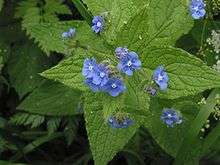Pentaglottis sempervirens
Pentaglottis sempervirens, the green alkanet,[1] evergreen bugloss[2] or alkanet, is a bristly, perennial plant native to Western Europe. It grows to approximately 60 cm (24") to 90 cm (36"), usually in damp or shaded places and often close to buildings. It has brilliant blue flowers, and retains its green leaves through the winter. The plant has difficulty growing in acidic soil (it is calcicolous). The name "alkanet" is also used for dyer's bugloss (Alkanna tinctoria) and common bugloss (Anchusa officinalis). Green alkanet is an introduced species in the British Isles.[3]
| Green alkanet | |
|---|---|
 | |
| Scientific classification | |
| Kingdom: | Plantae |
| Clade: | Tracheophytes |
| Clade: | Angiosperms |
| Clade: | Eudicots |
| Clade: | Asterids |
| Order: | Boraginales |
| Family: | Boraginaceae |
| Genus: | Pentaglottis |
| Species: | P. sempervirens |
| Binomial name | |
| Pentaglottis sempervirens (L.) Tausch ex L.H.Bailey | |
The word "alkanet" derives from Middle English, from Old Spanish alcaneta, diminutive of alcana, "henna", from Medieval Latin alchanna, from Arabic al-ḥinnā’, "henna" : al-: "the" + ḥinnā’, "henna". The genus name Pentaglottis is Greek, meaning "five tongues", and the species name sempervirens is Latin, and means "always alive", or "evergreen".
Green alkanet blooms in spring and early summer. Its stamens are hidden inside narrow flower-tubes which end in a white eye in the centre of a blue flower.
 Flower close-up
Flower close-up Stalk and flowers
Stalk and flowers Flower close-up
Flower close-up
References
- "BSBI List 2007". Botanical Society of Britain and Ireland. Archived from the original (xls) on 2015-01-25. Retrieved 2014-10-17.
- "Pentaglottis sempervirens". Natural Resources Conservation Service PLANTS Database. USDA. Retrieved 31 January 2016.
- http://www.nhm.ac.uk/fff-pcp/glob.pl?report=Flora&Flora.[FloraNo]=236800